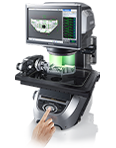Causes of Errors
The following are the major causes of errors that may occur during measurement.
(1) Errors caused by temperature
An object’s volume changes due to fluctuations in temperature, which also leads to changes in the object’s length. This applies not only to the measurement target but also to the measuring instrument. Changes in temperature and the length of an object can be expressed by the "thermal expansion coefficient." The thermal expansion coefficient varies depending on the material type. ISO defines the reference temperature for measuring length as 20°C.
- Major thermal expansion coefficients
-
Unit: ×10-6/K Diamond 1.0 Glass 8 - 10 Iron 11.8 Gold 14.2 Aluminium 23.1 PET plastic 70.0 Formula for amount of deformation due to thermal expansion:
ΔL = L (Length of material) × α (Thermal expansion coefficient) × ΔT (Temperature difference)
Note:
Values are based on a temperature condition of 293 K (20°C).
(2) Errors caused by material deformation
Applying force to an object causes it to change at a fixed ratio. The object will return to its previous state when the force is no longer applied. This change in the object’s shape is called "Elastic deformation." The force applied to the object is called “stress." In general, the relationship with the strain of the object is proportional. Therefore, this relationship can be expressed with the "Modulus of longitudinal elasticity (Young's modulus)."
The stronger the stress, the greater the strain. For example, care must be taken to avoid tightening the spindle too much when using an outside micrometer to measure the outside of an object.



